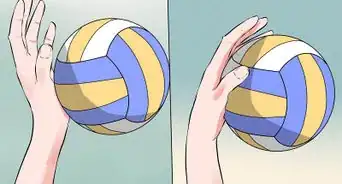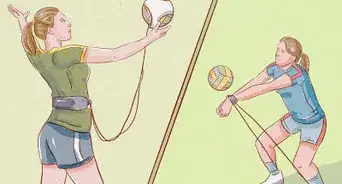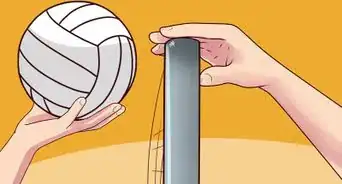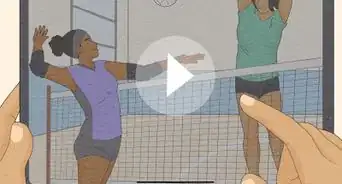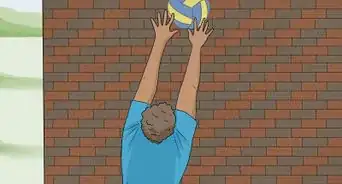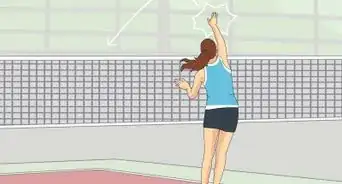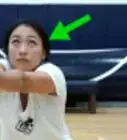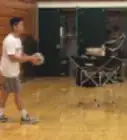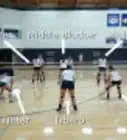This article was co-authored by wikiHow Staff. Our trained team of editors and researchers validate articles for accuracy and comprehensiveness. wikiHow's Content Management Team carefully monitors the work from our editorial staff to ensure that each article is backed by trusted research and meets our high quality standards.
wikiHow marks an article as reader-approved once it receives enough positive feedback. In this case, 100% of readers who voted found the article helpful, earning it our reader-approved status.
This article has been viewed 240,262 times.
Learn more...
In the sport of volleyball, performing an underhand serve is one of the most basic skills you will need. Serving is the only time in a volleyball match when you have the opportunity to be in control of a stationary ball, and you can also score a lot of points this way, so it's important to develop good technique. An underhand serve doesn't take as much strength as an overhand serve or as much practice as a jump serve, so it's great for beginners.
Steps
Positioning
-
1Get your feet into position. Stand with your non-dominant foot in front with your toes facing forward. Your dominant foot should be in the back with toes pointed slightly out.
- Shift your weight to your dominant foot.
- Make sure your hips are facing straight forward, not angled to the side.[1]
-
2Ready the ball. Cup your non-dominant hand slightly and place the ball in it. Make sure the ball securely balanced so it won't wobble or fall out of your hand. [2]
- Keep your fingers slightly loose to distribute the weight of the ball. This will help it stay balanced.
- Don't grip the ball with your fingers. You want it to be stable, but it still has to be able to fly out of your hand when you hit it.
Advertisement -
3Lower the ball. Bring the arm holding the ball across to the side of your body in front of your hitting arm. The ball should be at the height of your mid-thigh. [3]
- Straighten the arm with the ball in it, and move it to the side by shifting your arm at the shoulder, not the elbow.
- You want the ball to be low so that you can put more power into it as you move your whole body forward and up.
-
4Lean your shoulders forward. Move your hips back and keep your upper back straight as you bring your shoulders towards the ball. This brings your a little closer to the ball so that you have more control.
- Don't hunch over but make sure you aren't standing up straight.
- As your hips move back, you can raise the toes on your front foot so your heel is touching the ground and your toes are pointing up.
Aiming
-
1Choose a strategic place for the ball to land. You want to confuse the opposition as much as possible. If you are practicing on your own it might not seem as important, but when you're playing on a team you will want the ball to go where you aim it-- so practice aiming!
- First, practice aiming for the deep right or deep left of the court. This will force passers to move out of formation.
- After you practice that, begin aiming for places between players. This will cause players to be confused about who should get the ball, which will improve your strategic advantage. [4]
-
2Adjust your angle to the net. If you are aiming for the deep left, your shoulders will point left and your back foot will move slightly right, and vice versa. [5]
- Trace a straight line with your eyes across the court. Bring your eyes from your chosen landing spot to the point on the bottom of the ball where you will hit it.
- If you have to move your head to the side to trace a line from your landing point to your contact point, you should adjust your feet and shoulders so that you are facing your chosen landing point.
-
3Squeeze your hitting hand into a fist. Then, rotate your arm so that your closed fingers and the inside of your wrist are facing up.
- Picture your fist hitting the contact point on the ball, and following a line to the point where you want it to land.
- It is also possible to have your fist facing the side, with your wrist turned inside and your thumb facing up.
Serving
-
1Determine the arc of the ball. The desired arc of the ball depends on whether you want the ball to land in deep on the opposing side, or closer to you. Hitting the ball with more force forward will mean that the ball will fly lower and faster to the back of the court, while hitting the ball upward will mean that the ball will fly higher and land closer to you.
- Usually, low arcs that end deep are desirable in volleyball. They are hard to pass and control, and so it is more likely that you can score points on them.
- If you know that two people closer to the front will be confused by a serve landing between them, you can aim for a higher arc that ends there.
- If you are looking for more speed and control, you may want to try an overhand serve.
-
2Draw your hitting arm straight back. It should move quickly, like a pendulum. Then swing it forward firmly, hitting the bottom of the ball with your closed fist.
- You should hit the ball just below the center so it will follow an upward trajectory over the net.
- Speed up your swing just before you make contact with the bottom of the ball.
-
3As you swing your arm, step forward. You should shift your weight onto your non-dominant foot, which should be in front. Move your whole body forward and up, propelling the ball over the net.
-
4Follow through with your arm. Your arm should continue in an upward arc after you hit the ball. Bringing your arm all the way up will better guarantee a straight and true flight path over the net.
- Keep your arm straight. It should swing straight up like a pendulum, to a height equal to or just above your head.
- Recall the imaginary line you traced from your landing point to your contact point. Your fist should trace over that line as it follows through.
-
5Get into a ready position. After you serve the ball, get ready immediately. Stand facing forward with your feet shoulder width apart, legs bent, and arms straight down in front of you with hands clasped together.
- Allow your arms to linger on the follow-through before clasping them together to get ready.
- You can briefly check to see how your ball lands, but don't get too distracted to do your part when the ball comes back over the net.
Community Q&A
-
QuestionWhen I hit the ball, my hand immediately starts to hurt. Is this a sign of injury and how can I prevent this?
 Community AnswerIt’s not a sign of injury. Sometimes, when players hit the ball at places they aren’t used to hitting at, they get bruised and the spot starts to hurt. It’s a thing most volleyball players go through, but it just proves how tough you are.
Community AnswerIt’s not a sign of injury. Sometimes, when players hit the ball at places they aren’t used to hitting at, they get bruised and the spot starts to hurt. It’s a thing most volleyball players go through, but it just proves how tough you are. -
QuestionDo I look at the ball while serving?
 Community AnswerYes, especially if you are just starting out, though you should always be aware of your surroundings.
Community AnswerYes, especially if you are just starting out, though you should always be aware of your surroundings. -
QuestionMy ball goes high enough, but by the time it gets to the net it doesn't go over. I really want to make the team, but I can't serve. What do I do?
 Pranathi SelvakumarCommunity AnswerTake one step at a time. Focus on the ball, and also make sure your hand movements are correct. When you serve the ball, you can try to move the arm you're serving with upwards a little more so you get a little more height. Believing in yourself is the most important thing. If you have time before tryouts, talk to the coach or anyone you know who is good at serving and get some tips.
Pranathi SelvakumarCommunity AnswerTake one step at a time. Focus on the ball, and also make sure your hand movements are correct. When you serve the ball, you can try to move the arm you're serving with upwards a little more so you get a little more height. Believing in yourself is the most important thing. If you have time before tryouts, talk to the coach or anyone you know who is good at serving and get some tips.
Warnings
- A soft ball will be best for learning to serve and will be less painful.⧼thumbs_response⧽
References
- ↑ http://volleyball.isport.com/volleyball-guides/how-to-serve-a-volleyball
- ↑ https://www.youtube.com/watch?v=kZFbkbqG7J8&feature=youtu.be&t=22s
- ↑ http://volleyball.isport.com/volleyball-guides/how-to-serve-a-volleyball
- ↑ https://www.youtube.com/watch?v=iGQUk9W5zJI&feature=youtu.be&t=2m11s
- ↑ http://www.strength-and-power-for-volleyball.com/how-to-serve-a-volleyball.html
About This Article
If you play volleyball, you’ll need to learn how to do an underhand serve. Stand with your non-dominant foot in front and your dominant foot in the back. Shift your weight to your dominant foot as you hold the ball in your non-dominant hand. Lower the ball so it’s at mid-thigh so you can hit it with more power. As you move your hips back, lean over so your shoulders come down toward the ball while keeping your back straight. Squeeze your hitting hand into a fist and rotate your arm so your wrist is facing up. Then draw your hitting arm straight back, swing it forward firmly as you step forward, straighten your back, and hit the ball. To learn how to aim the ball when you’re serving, keep reading!













